This guide details the meanings of print codes and edition markings on Ordnance Survey map sheets, from 1900 to the present day. The various styles of print codes can be roughly divided as follows:
| c.1900 - c.1922:
First printings of each sheet in a series did not carry print codes; only a year of publication was given. Subsequent revisions or printings had a print code added to them in the style 6.12. This indicated the month and year of printing - in this case, June 1912. | 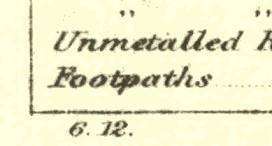 Detail of bottom-left corner of the 1-inch map of Oxford & District, showing the print code and part of the legend panel. |
| c.1923 - c.1934:
First printings again did not carry print codes, only the year of publication. Revisons and reprints were given print codes in the following format: 3000/29. This indicated the number of copies (nominally) in the print run, and the year of printing - in this case, 3000 copies printed in 1929. Sometimes, these codes were simply tacked on to the end of the previous print code(s), e.g. 500/28.3000/29.500/30.200/32. The relevant code is always the last in the list. | 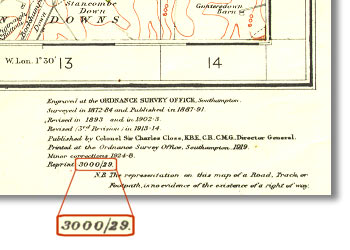 Bottom-right corner of Popular Edition sheet 104, showing how to identify the print code. |
| c.1935 - c.1940:
Every printing of each sheet was given a print code. The format of the code was a contraction of the previous style, e.g. 3036. In this case, the code indicates 3000 copies, printed in 1936. Some print codes towards the end of this era have an extra part tacked on the end, e.g. 3038.M37.R37. The M37 indicated that minor changes up to 1937 were incorporated; the R37 indicated that changes to roads and railways up to 1937 were incorporated in the sheet. Some codes have an additional slash - e.g. 50/38. On the small-scale maps, this would mean the same as 5038 - 5000 copies printed in 1938; on large-scale maps (6-inch and larger) the print code had the same format as pre-1934, thus 50/38 would indicate 50 copies printed in 1938. In all cases, the print codes could sometimes be tacked on to the end of the previous print code(s), e.g. 1535.3036. | 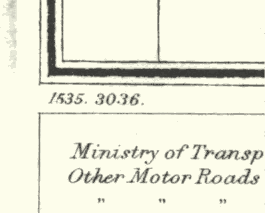 Detail of bottom-left corner of Popular Edition sheet 93, showing the print code and part of the legend panel. |
| c.1940 - c.1945:
Again, every printing of each sheet had a print code. The format was similar to that of the previous style, but contained more information. 20,000/1/43 R, for example, indicates 20,000 copies, printed in January 1943 at printing company code R (Robinsons). | 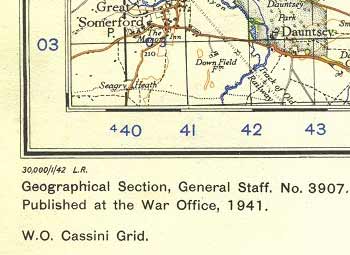 Bottom-left corner of War Revision sheet 104, showing the corner of the map plate, the print code, and part of the legend/information panel. |
| c.1945 - c.1947:
Each printing was given a print code, in an identical format to that used immediately pre-war. 20,046, for example, indicated 20,000 copies printed in 1946. Some codes had an addition at the end: either /Ch or /Cr. This indicated that the map sheet was printed at Ordnance Surveys offices at either Chessington (Ch) or Crabwood (Cr). Crabwood is the site of the current Ordnance Survey headquarters. | 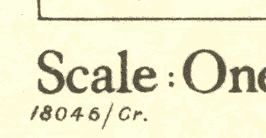 Detail of bottom-left corner of New Popular Edition sheet 156, showing the print code and part of the legend panel. |
| c.1947 - c.1953:
The print codes used on small-scale maps during this time are not nearly as informative as the previous codes. They are simply an indication of a print job reference, and are given the name unique numbers because no two sheets/revisions would have the same print code. Sheets in the 1-inch New Popular Edition, for example, had print codes running from 1001 to 1307. Ordnance Survey started to use letters to indicate revisions of a sheet from 1947, first appearing on the new 1:25 000 sheets. The first printing of a sheet was given the edition code A. Subsequent reprints or revisions to the sheet changed the edition code by incrementing the letter, e.g. | 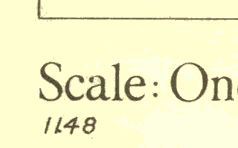 Detail of bottom-left corner of New Popular Edition sheet 158, showing the print code and part of the legend panel. |
| c.1953 - c.1960:
The letter style of edition code spread to the rest of the scales from 1953, and was slightly modified. The first printing of a sheet was still given the edition code A. Subsequent revisions to the sheet changed the edition code thus: minor changes added one bar of underlining to the letter, and full revisions incremented the letter and removed any additions. For example, | 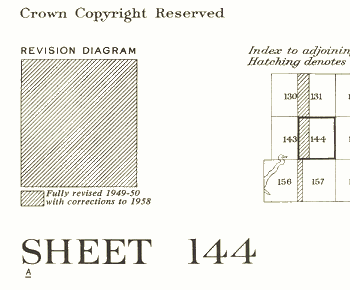 Bottom-left corner of 1-inch 7th Series sheet 144, showing the edition code (A) and part of the legend panel. |
| c.1960 - c.1988:
A slight change was made to the system in May 1960: an asterisk and one bar of underlining was added to the existing code to indicate major changes. For example, From 1981, the 1:50 000 scale map sheets were printed with an additional code at the very bottom-right of the legend panel. This is in a similar style to the wartime military print codes, e.g. 20,000/4/89/890231 S. This indicates how many copies in the print run, month and year of printing, and print run number; in this case: 20,000 copies, printed in April 1989, print run number 890231 (print run 0231 from year 1989). The S indicates the printing location - Southampton. | 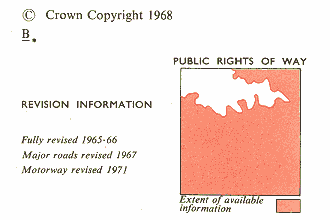 Bottom-left corner of 1-inch 7th Series sheet 157, showing the edition code (B*) and part of the legend panel. |
| c.1988 - present:
The edition code style was slightly changed again in April 1988. Minor changes still add a single bar of underlining, but major changes remove underlining and add/increment a number after the letter, e.g. | 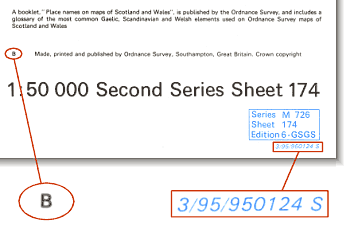 Bottom-right corner of 1:50 000 (Landranger) series sheet 174, showing how to identify the edition code (B) and the print code (3/95/950124 S). |
With thanks to Richard Oliver and Lez Watson for their help in clarifying the meanings of some print codes.
Page last updated: 19 December 2009
 > revision >
> revision >  .
.
 > minor changes >
> minor changes >  > full revision >
> full revision >  .
.
 > full revision >
> full revision >  .
.
 > minor changes >
> minor changes >  > major changes >
> major changes >  . Full revisions still increment the letter and remove any underlining or numbers, e.g.
. Full revisions still increment the letter and remove any underlining or numbers, e.g.  . The military print codes were shortened around 1989, with the removal of the indication of the number of copies in the print run, e.g. 3/95/950124 S. Between 2002 and mid-late 2009, the print codes cannot be relied upon as a definite date of printing - the print code simply indicated the date of first printing of the military edition, which was not wholly co-incident with the civil edition. In September 2009 a simple month/year print code was introduced to the Landranger Series in the format 09/09.
. The military print codes were shortened around 1989, with the removal of the indication of the number of copies in the print run, e.g. 3/95/950124 S. Between 2002 and mid-late 2009, the print codes cannot be relied upon as a definite date of printing - the print code simply indicated the date of first printing of the military edition, which was not wholly co-incident with the civil edition. In September 2009 a simple month/year print code was introduced to the Landranger Series in the format 09/09.